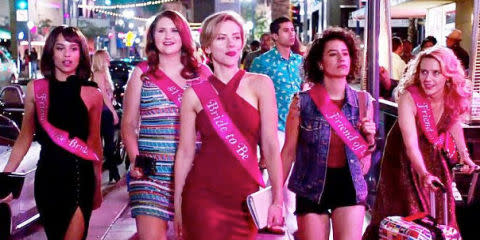This Is Why We Have Bachelor and Bachelorette Parties

Bachelor and bachelorette parties are a time-honored tradition, typically involving a wild night out sometime shortly before getting married. These last hurrahs can be controversial, especially since the stereotypical bachelor party involves hard partying and possibly strippers (see: The Hangover). In fact, Mario Lopez and Nick Lachey were both involved in bachelor party scandals - Lopez straight up admitted to cheating on his ex-wife (of two weeks) Ali Landry at his own bachelor party, while rumors that Lachey had been unfaithful to Jessica Simpson at a friend's "wild bachelor party" were cited as possible reasons for their eventual 2005 split.
Of course, not every bachelor or bachelorette party is a cesspool of infidelity. Plenty of men and women have low-key celebrations to mark their last days of being a bachelor/bachelorette - or can be trusted to not cheat on their partner under any circumstances (probably a helpful thing to know prior to tying the knot).
But when, exactly, did bachelor/bachelorette parties first become a tradition? Like many modern things, the concept is popularly traced back to ancient Greece. Bachelor parties are thought to date back as early as the 5th century B.C., according to TIME, with ancient Spartans celebrating the groom-to-be's last night as a free man.
Yep, these Spartans:
Well, OK, not those (fictional) Spartans. But close enough.
At a Spartan bachelor party, according to Slate, there would be toasts at a massive feast, where "the soon-to-be-wed pledged his continued loyalty to his brothers-in-arms." Of course, the term "bachelor" (or its ancient Greek equivalent) wasn't used back then to describe the "soon-to-be-wed." The term "bachelor" first came into popular usage to describe an unmarried man a solid millennium later (give or take a year), thanks to Geoffrey Chaucer's The Canterbury Tales, which was published in the 15th century.
By 1922, etiquette expert Emily Post hilariously described bachelor parties like this: "Popularly supposed to have been a frightful orgy, and now arid as the Sahara desert and quite as flat and dreary, the bachelor dinner was in truth more often than not, a sheep in wolf's clothing. [...] [T]he groom's farewell dinner is exactly like any other 'man's dinner' [...] Usually there is music of some sort, or 'Neapolitans' or 'coons' who sing, or two or three instrumental pieces, and the dinner party itself does the singing. Often the dinner is short and all go to the theater."
That's one take on what went down at a bachelor party of around a century ago, though the accuracy of what Ms. Post has to say is questionable, to say the least. Take, for one example to the contrary, the infamous 1896 so-called "Seeley Bachelor Party Orgy" of P.T. Barnum's grandson, which was raided by the police after rumors circulated that a famous belly dancer was set to perform "indecent dances" in the nude for party guests.
Bachelorette parties (in their modern form) followed a different trajectory and started much later. Their rise is typically tied to the women's sexual revolution of the 1960s and their increased presence in the workforce around the same time. Traditional bridal showers (which are thought to have originated in 16th century Holland, as an alternative to the dowry system) gave way to the more sexually rambunctious and wild bachelorette celebrations of today. But it wasn't until 1981 that the first notable usage of the phrase "bachelorette party" appeared in print," in a New York Times article about then New York Governor Hugh Carey's remarriage and his wife-to-be's pre-wedding celebration at the 21 Club. And in 2017, we're got Rough Night, a Scarlett Johansson-led movie in which a group of friends accidentally kill a stripped during their bachelorette festivities. We've come so far!
Follow Redbook on Facebook.
You Might Also Like

